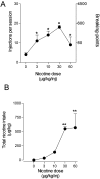High reinforcing efficacy of nicotine in non-human primates
- PMID: 17311094
- PMCID: PMC1794142
- DOI: 10.1371/journal.pone.0000230
High reinforcing efficacy of nicotine in non-human primates
Abstract
Although tobacco appears highly addictive in humans, there has been persistent controversy about the ability of its psychoactive ingredient nicotine to induce self-administration behavior in laboratory animals, bringing into question nicotine's role in reinforcing tobacco smoking. Because of ethical difficulties in inducing nicotine dependence in naïve human subjects, we explored reinforcing effects of nicotine in experimentally-naive non-human primates given access to nicotine for periods of time up to two years. Five squirrel monkeys with no experimental history were allowed to intravenously self-administer nicotine by pressing one of two levers. The number of presses on the active lever needed to obtain each injection was fixed (fixed-ratio schedule) or increased progressively with successive injections during the session (progressive-ratio schedule), allowing evaluation of both reinforcing and motivational effects of nicotine under conditions of increasing response cost. Over time, a progressive shift toward high rates of responding on the active lever, but not the inactive lever, developed. The monkeys' behavior was clearly directed toward nicotine self-administration, rather than presentation of environmental stimuli associated with nicotine injection. Both schedules of reinforcement revealed a high motivation to self-administer nicotine, with monkeys continuing to press the lever when up to 600 lever-presses were needed for each injection of nicotine. Thus, nicotine, by itself, in the absence of behavioral or drug-exposure history, is a robust and highly effective reinforcer of drug-taking behavior in a non-human primate model predictive of human behavior. This supports the use of nicotinic ligands for the treatment of smokers, and this novel preclinical model offers opportunities to test future medications for the treatment of nicotine dependence.
Conflict of interest statement
Figures





References
-
- Stolerman IP, Shoaib M. The neurobiology of tobacco addiction. Trends Pharmacol Sci. 1991;12:467–473. - PubMed
-
- Fiore MC, Bailey WC, Cohen SJ, Dorfman SF, Goldstein MG, et al. Treating tobacco use and dependence. Clinical practice guideline. Rockville, MD: U.S. Department of Health and Human Service. Public Health Service; 2000.
-
- Robinson JH, Pritchard WS. The role of nicotine in tobacco use. Psychopharmacology (Berl) 1992;108:397–407. - PubMed
-
- West R. Nicotine addiction: a re-analysis of the arguments. Psychopharmacology (Berl) 1992;108:408–410. discussion 411–406. - PubMed
-
- Dar R, Frenk H. Nicotine self-administration in animals: a reevaluation. Addict Res Theory. 2002;10:545–579.
Publication types
MeSH terms
Substances
LinkOut - more resources
Full Text Sources
Other Literature Sources

